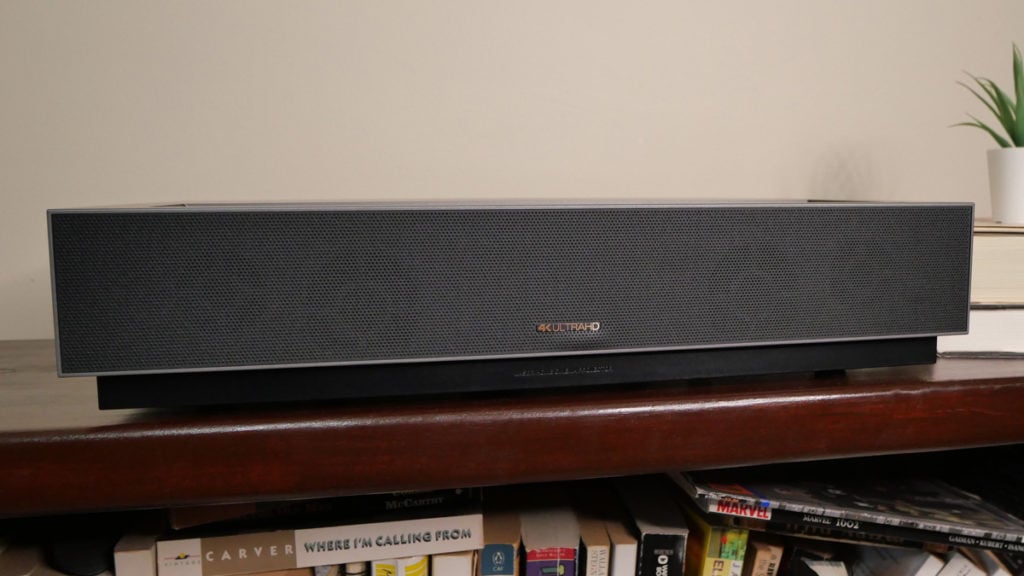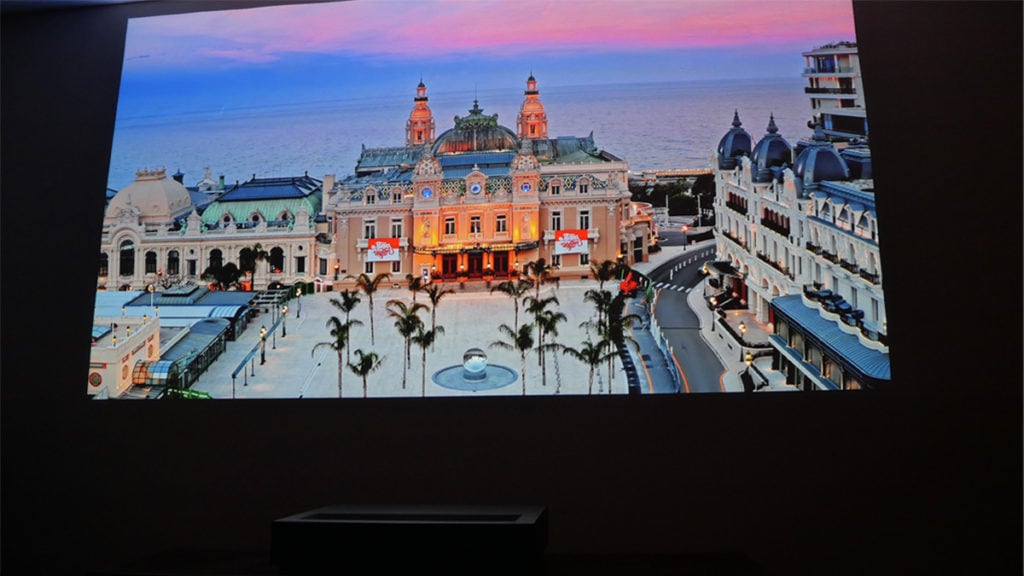Wemax Nova Laser TV 4K is a ultra short throw projector that has a bright picture, impressive native contrast and SDR color.
Overall, the picture quality and audio delivers a remarkably immersive movie-watching experience. But consistent HDR10 support is an area that could be improved.
Overview of Wemax Nova Laser TV 4K
An ultra short-throw projector (a.k.a. UST projector) only needs to be a foot or two away from a wall to cast a crisp screen that’s more than 100 inches. Home theater projectors and portable projectors need to be 10 to 12 feet away from a screen or wall to create a similar screen size.
The Wemax Nova 4K Laser TV uses ALPD 3.0, which stands for Advanced Laser Phosphor Display. The 3.0 generation of this technology is from Wemax’s parent company, Appotronics, and developed for use in cinemas.
The Nova is a DLP projector with a 1,300 ANSI lumen rating. Because of its short throw range, a Laser TV can fit into a room where traditional projectors won’t work. If you live in a high-rise building with a small elevator, a large screen TV might be a tough fit.

A UST projector is not a Smart TV, but it’s certainly an alternative to consider. You can watch the Wemax in a room with ambient light, but you will get a much better experience in a dark room.
Large TVs with impressive 4K and OLED displays are dropping in price every year. And ultra-short throw projectors, which came to the market around 2014, are doing the same.
The Wemax Nova 4K laser projector uses Android TV OS (version 9.0). It is still as expensive as a high-end TV at $2,699. The XGIMI Aura, Samsung Premiere and Optoma P2 offer similar or better specs, but come at a higher price.
Design
The projector is about the size of a small suitcase. It has two small legs in the back and a third, larger one in the front at the center. On the left and right side of the Nova, there are height adjustable wheels for each back leg.
The projector is 18 inches wide, 12 inches from front to back and 3 and half inches tall. It weighs just over 15 lbs. (7.0 kg), making it easy to carry and move.
The Wemax Nova 4K fit just fine on a bookshelf in my office that’s just under 12 inches wide. The center of the laser was about 17 and a half inches from the wall I used as a screen.
The back of the projector has three HDMI ports including one with ARC support. There is a USB 2.0 port for a flash drive with stored media. There are ports for audio output, AV input, Ethernet and S/PDIF optical digital audio.
The two full range speakers are at the front of the projector along with two tweeters. The heat from the light source is dissipated through air that is drawn in from fans on the left side and pushed out on the right.
Setup
Installation of the projector is pretty simple. You have the option of placing the Wemax Nova on a bookshelf, or entertainment stand. You will find options for rear projection on desktop, and front or rear projection from a ceiling mount under settings.
On the software side, setting up the Wemax Nova 4K is similar to any streaming device or Smart TV that uses Android TV or Google TV software. The Google Home app adds your favorite apps and preferences into the Nova’s Android TV OS.
You can go through the setup process using the projector’s remote control if you are not a regular user of Android.
Getting the Nova 4K connected to your home network is a crucial step because you will want to check for a software update before you start using the projector.
The Nova 4K is set up like most UST models with manual focus and keystone correction. Wemax’s software does a pretty good job with helping you fine tune keystone correction with four-point and 8-point modes.
The adjustments are made through the remote control. Having the word “WEMAX” in all four corners of the test screen also helps with manual focus.
You may need to use the adjustable feet dials to line up the projector with the wall. You can return to the adjustment settings by launching the “Launch Board” app, which is a pre-installed app.
Ideally, you would use this projector with a high quality indoor screen. I didn’t have one for indoor use on hand, so I used my white office wall. (Wemax has been including a 100-inch Rollable Ultra-short ALR Screen when customers buy the Nova 4K directly from their website.)
Picture quality
The Wemax Nova has 1,300 ANSI lumens at 60Hz, and uses patented Advanced Laser Phosphor Display (ALDP) 3.0 technology. The Nova uses a 1080p Digital Imaging Chip (DMD) with fast XPR pixel-shifting to deliver 4K picture resolution.
The settings under “Image Mode” have presets for Standard, Movie, Vivid, Sports, Child and User.
I found that the User mode was the best overall.

The User mode is where you can fine tune brightness, contrast, saturation, sharpness and hue. There are three options under color temperature: standard, warm and cold. I kept the digital noise reduction on low or auto, and found little difference between the two.
If you don’t like to fine tune contrast or saturation like I do, Standard mode and Movie mode both had a decent balance among all the elements of a good image. Sports mode is more vivid. And Vivid mode is very similar.
While researching the projector, the Nova 4K initially had a Game mode, but it was not present after I got the latest software update. Unlike UST projector models from LG, Samsung, Hisense and others, you won’t find more calibration modes on the Wemax Nova 4K.
Performance
I watched a number of movies and TV shows, including “Top Gun: Maverick” streaming on Paramount+, and the latest season of “Tom Clancy’s Jack Ryan” on Amazon Prime. Both the image quality and audio were impressive.
A movie with fast action, and big landscapes really shows off the capabilities of the Wemax Nova 4K giving you a theater-like experience at home.
The deep blacks, and Wemax’s 3,000:1 native contrast delivers an immersive SDR picture.
The Android TV software on the Wemax Nova has full access to the Google Play Store. You will find a number of apps you would expect such as Amazon Prime Video, Disney+, HBO Max, Hulu, ESPN and Showtime. I even found lesser known favorites such as The Criterion Channel supported.
The Nova has a built-in Chromecast, so you can also stream videos and photos from a smartphone or tablet.

But like many projectors that I have reviewed over the years, there is no native support for Netflix. You can connect any streaming device such as a Roku or Amazon Fire TV Stick that supports Netflix instead.
One thing that stood out to me while testing out Android TV on the Wemax versus using a 4K streaming device. Streaming apps on the Nova’s native software did not always offer a 4K or UHD version of a TV show or movie that I wanted to watch.
YouTube always presented videos in 4K with Nova’s native software, and I even dug into the “stats for nerds” to make sure.
So for example, if I went to Amazon Prime and chose “Tom Clancy’s Jack Ryan ”, episodes were made available only in HD. But if plugged in a NVIDIA Shield, Amazon Prime would offer the same episode in 4K or UHD. With Disney+, I always got the HD version of movies or shows no matter what I used.
With the NVIDIA Shield, I was able to use the 4K setting at 30Hz. HDR10 is supported through the HDMI port. But I had issues seeing consistent HDR10 through streaming services.
I suspect that the streaming apps can’t always rectify that Wemax Nova is upscaling to 4K. Having said that, many of the small details that I would look for in a 4K image (such as wrinkles or tiny hairs on a face or neck) stood out regardless of what I was using for streaming.
Inputs
All of the inputs worked well. There is an Ethernet port, which I tested out after using Wi-Fi for a while. My router was to the left of the Nova 4K so I didn’t see a significant difference in download speed by using Ethernet.
I liked having three HDMI ports. It allows you to have a game console, Blu-Ray player or even a laptop all connected to the Nova 4K at the same time. The third HDMI port in the back of the projector has ARC support.
You can turn on Consumer Electronic Controls (CEC) through the settings. When I connected the NVIDIA Shield, I was able to use its remote to control both power and volume with its remote. That was great. But I wish there was a setting within the Nova 4K software that allowed me to launch directly to the NVIDIA Shield or another streaming device instead of the native software.

This is a feature that you even see with budget 4K TVs.
The single USB ports was also a welcome addition, allowing me to plug in a flash drive to view photo or video files. The AV input is a 3.5 composite AV port. The audio outport port supports subwoofers or a soundbar. There is a S/PDIF port for optical output to a soundbar as well.
You can also connect wireless headphones through Bluetooth. The projector can function as a standalone Bluetooth speaker for a connected smartphone or tablet.
Remote control
The remote control uses two AAA batteries, and has a slender design that fits well in the hand.
The controls include a navigation wheel, power button, and volume rocker. There are dedicated buttons for the home screen, and the apps store. A go-back button is between them.
The Google Assistant button is at the top of the remote, and you can use it to search for movies, or TV shows across all your streaming apps. You can filter your choices by actors, directors and even what’s available for free.

I would have liked to have seen buttons for mute, settings, and input controls. These are buttons that are on remotes for projectors from XGIMI and BenQ.
Since I subscribe to streaming services that are ad-supported, I use the mute button quite a bit so I don’t have to listen to commercials. I can turn the volume all the way down to mute, but it’s not as quick or convenient as a mute button.
The Nova has three HDMI ports and audio ports to connect other hardware, so it would only make sense if the remote had a button to quickly switch over to a game console or another streaming device.
Audio
The audio is powered by two 10W full range speakers and a pair of 5W tweeters. For most of my testing, I was on a futon about 8 to 10 feet away from the projector. The audio was robust and loud enough that I didn’t feel the need to attach any more speakers.
When I was watching movies, I was really pleased with the nuance and depth of what I was hearing from the speakers. The speakers are certified for Dolby Audio and DTS HD.
I wasn’t as impressed with the sound quality when I tried using the projector as a standalone Bluetooth speaker. But this is a minor issue, and by no means a deal breaker for me. I personally wouldn’t use this function anyway.
Conclusion
The Wemax Nova 4K projector has great color accuracy and native contrast. This is an entry-level Laser TV that has a very solid, and bright picture with SDR. The upscaled 4K is reliable.
The picture and audio delivered an immersive experience, especially for watching movies that demanded a larger-than-TV-size screen. But the picture quality is as good or better than other DLP and high-end portable projectors that I have tested.
The HDR10 support was a struggle to find using a NVIDIA Shield TV and a Chromecast 4K with Google TV. You are better off just sticking with SDR. There is no Dolby Vision support. Despite those shortcomings, the deep blacks and contrast really stood out.
A home theater purist could spend more money, and find better calibration and HDR support. But for it’s price, the Wemax Nova 4K delivers an excellent experience for an entry-level short-throw projector to watch sports or a movie.
Wemax Nova 4K UHD Projector FAQs
These are questions readers ask about the Wemax Nova 4K while researching USD projectors.
Is Wemax Nova native 4K?
Like a number of UST projectors, the Wemax Nova uses a 1080p Digital Imaging Chip (DMD) with fast XPR pixel-shifting to deliver 4K picture resolution.
What is the ultra short throw ratio on the Wemax Nova 4K?
The throw ratio is 0.233:1.
What is the storage and RAM on the Wemax Nova 4K?
The RAM is 2GB DDR3, and the internal storage is 32GB eMMC high-speed flash memory. The built-in storage gives you plenty of space for streaming TV apps and some casual games within the Google Play Store.
Is the Wemax Nova 4K projector as good as a TV?
The Wemax Nova 4K is bright enough to deliver a clear picture on a 100-inch screen in a room with ambient light. But the overall experience of a laser TV or laser projector is closer to a home theater experience than watching a television.
Can you connect the Wemax Nova 4K to an iPhone?
Yes. The Wemax Nova 4K has built-in Chromecast, so you can connect an iPhone, iPad, Android smartphone or tablet.
Where to buy the Wemax Nova 4K projector
You can buy the Wemax Nova 4K at a number of online retailers, including directly from the company.
- Wemax Nova 4K projector at the Wemax website
- Wemax Nova 4K projector at Walmart
- Wemax Nova 4K projector at Amazon
For more news on streaming, how-to guides and reviews, head over to the main page of The Cord Cutting Report or follow the CCR on Google News.